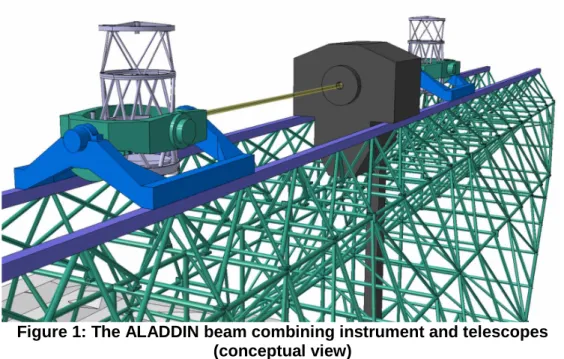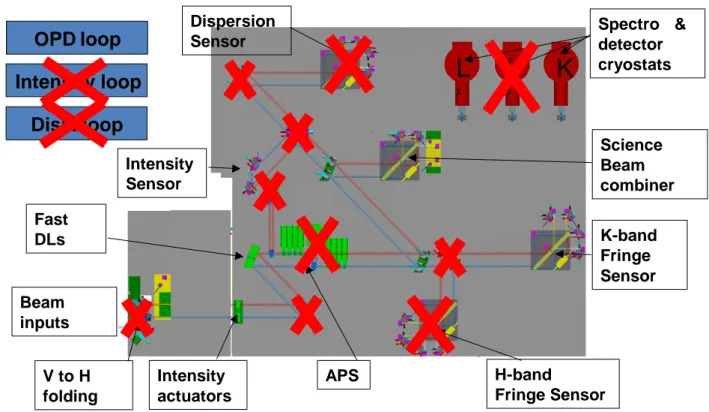ALADDIN NULLING INSTRUMENT
Marc Barillot1, Vincent Coudé du Foresto2, Jean Surdej3, Olivier Absil3, Claude Jamar4, and Emmanuel Di Folco2
1 Thales Alenia Space 2 Observatoire de Paris – LESIA
3 Université de Liège – AGO 4 AMOS
ABSTRACT
The ALADDIN project aims at detecting warm dust populations around nearby main sequence stars. In order to achieve the significantly improved sensitivity with respect to existing instruments, the architecture of the system is focused and optimised for the mission: ALADDIN implements the nulling interferometry technique at the focal plane of a 2-telescope interferometer mounted on a rotating structural beam.
Concerning the beam combining nulling instrument, the ALADDIN design is inherited from a Definition Study of the VLTI/GENIE instrument, performed a few years ago by an industrial consortium for the European Space Agency and the European Southern Observatory.
In this paper, we demonstrate how the ALADDIN instrument preliminary definition can be made simpler and more representative of a space instrument than GENIE thanks to both the outstanding atmospheric properties of Dome C and the dedicated architecture of the system. In particular, real-time controls of the chromatic dispersion of the phase and intensity matching can be discarded, while the remaining control of the phase is substantially relaxed. Furthermore long-stroke delay lines and dispersion correction hardware can be removed from the optical table.
Finally, we discuss the compatibility of the instrument with the Antarctic environment and constraints, and underline the experimental and industrial know-how learnt from the MAII and PERSEE nulling breadboards in which our Team is also involved.
1 INTRODUCTION 1.1 Context
This paper focuses on the beam combining instrument of the ALADDIN project, which aims at the characterisation from Antarctica of exozodiacal light around nearby stars. The whole project lies in the context of the search for terrestrial exoplanets and is presented by Coudé du Foresto in a parent paper1.
ALADDIN features two 1m diameter collectors accommodated on a straight ~40m long structural beam positioned 18m above the ground (Figure 1). The latter can be oriented in azimuth so that the source is maintained at the meridian of the baseline. The nulling interferometer instrument lies at equal distances between the collecting telescopes, on the rotating axis of the beam.
Figure 1: The ALADDIN beam combining instrument and telescopes (conceptual view)
The selected operating wavelength is the L, or L' band, which represents a good compromise between the thermal background, turbulence effects versus wavelength, and contrast between the star and the surrounding disk or companion(s).
1.2 Performance requirements
The performance goal of ALADDIN is quite challenging. Specifically, the instrument must be able of very deep nulling: a stable rejection ratio above 10000 is required so that the faint exozodiacal light can be discriminated from the star and background signals. This calls for quite accurate symmetry of the interfering beams. The optical path difference, including its chromatic dispersion over the spectrum, must be balanced to nanometric accuracy. The amplitude of the interfering beams must match to below 1%. Accurate polarisation matching is also required.
A more detailed description of the performance and instrumental requirements is provided in a parent paper by Absil2.
1.3 Heritage
A first attempt to design a nulling instrument for exozodiacal light characterisation was made in the years 2003-2004 with the Definition Study of the VLTI/GENIE project3 under the leadership of ESA and ESO.
It must be underlined that in a temperate site, preserving the nulling performance in turbulent conditions can only be achieved through extensive use of cutting-edge real time controls4. A quite complex instrument layout results, as shown in Figure 2, complemented by a set of real-time electronics of similar, if not worse, complexity.
Figure 2: VLTI/GENIE instrument layout 2 CONCEPTUAL DESIGN OF THE INSTRUMENT
Because of the complexity and development risks of VLTI/GENIE, the project was not continued. This is where the remarkably quiet Antarctic atmosphere comes in, along with the rotating beam architecture, to provide substantial simplifications of the instrument (Figure 3). The ALADDIN instrument comprises the same basic functionalities (fringe tracking, wavefront modal filter, beam combination, modal filtering, spectral dispersion and detection), except for two critical control loops and a spectral dispersion corrector that are not needed any more.
Indeed, since the source can always be maintained at the meridian of the baseline by means of beam rotation, the need for a long movable delay line vanishes. As a result, ALADDIN can be operated without any dispersion correction thanks to the very low water vapour seeing. Moreover, real-time intensity control is not required any more since the size of the collectors is significantly smaller than the Fried parameter in the L band, which is about 4 m. The Achromatic π-Phase-Shift can be achieved by means of opposite periscopes.
Eventually, only the fringe tracking system and two tip-tilt servo loops are required to co-phase and balance the beams. They are expected to be operated at reasonable repetition frequencies, compared to a temperate site, thanks to the more favourable temporal behaviour of atmospheric turbulence at Dome C.
Beam inputs Intensity actuators Fast DLs APS K-band Fringe Sensor H-band Fringe Sensor Science Beam combiner Spectro & detector cryostats Dispersion Sensor Intensity Sensor
OPD
loop
Intensity loop
Disp
.
loop
K
L
’
L
’
V to H foldingFigure 3: From GENIE to ALADDIN instruments
3 COMPLIANCE WITH THE ANTARCTIC ENVIRONMENT
In the Antarctic environment, human intervention is far more difficult than in temperate sites. Furthermore, ALADDIN must be independent from the existence or not of an astrophysical infrastructure at Dome C. Therefore ALADDIN should be capable of autonomous and fully remote controlled operation. Manual adjustments and calibrations should be minimized and practically limited to some alignment verification, feasible in regular roomspace (no cleanrooms !) after delivery on site.
In the same spirit, ALADDIN is proposed to be dismantled immediately after having completed its main mission, thus leaving the space, and possibly pieces of infrastructure, available for other instruments.
As an important consequence, end-to end functional validations of the equipment and of all the assembly, adjustment, calibration and operation procedures should be achieved in a temperate location, before the whole apparatus is sent to Dome C. This again strongly argues in favour of an autonomous and dedicated mission, which will be free from the inevitable complexity of design and operation of a multi-purpose instrument, and of the validation of the interfaces with a multi-purpose infrastructure.
Thanks to the presence of space industry in the project team, the development of such a remote-controlled, autonomous and reliable instrument can be considered realistic.
From the point of view of respecting the integrity and cleanliness of the Antarctic site, the ALADDIN instrument is fully conventional, since it is completely enclosed into a vacuum chamber, whose external surfaces and equipment are definitely conventional. Power consumption and data rate are also expected to meet the requirements of the Dome C site with margins.
4 DEVELOPMENT AND SCHEDULE 4.1 Technical heritage
In addition to the above-mentioned Definition study of the VLTI/GENIE instrument, the Project Team has accumulated practical experience in the laboratory, working on two nulling interferometry experiments.
The Multi-Aperture Imaging interferometer (MAII) has been developed by Thales Alenia Space for ESA since 2001. Its main purpose is to demonstrate deep nulling in different instrumental configurations. The major achievement5 is a stable and repetitive rejection ratio of about 10-5, ten times better than the ALADDIN requirements, along a polychromatic spectral band (5% wide in the near infra-red) and in non-polarised conditions. A typical recording of such results is shown in Figure 4.
Figure 4: MAII bench and nulling results
Testing nulling robustness facing perturbations is the aim of PERSEE, a CNES-led Research and Technology project involving Observatoire de Paris, ONERA, Observatoire de la Côte d'Azur and Thales Alenia Space. PERSEE is now entering the Integration phase, and will start its operations with nulling demonstrations in the presence of perturbations simulating the Formation Flying behaviour of the PEGASE satellite constellation. In a later phase, the simulation of atmospheric perturbations typical of Dome C conditions will be possible; in that respect PERSEE can be considered a major tool for the validation of ALADDIN.
4.2 Main phases and schedule
A typical and realistic sequence, which opens the door to Science operations of ALADDIN at horizon 2020, is shown in Table 1 hereafter.
Table 1: ALADDIN development schedule
Date Phase
2009 Proposal for Feasibility-Def Study 2010-11 Feasibility-Prel. Def Study – Cost 2012-13 Detailed Design Study 2014-15 Assembly and integration
2016 Validation on temperate site end 2016 – beg. 2018 Shipment and Integration @ Dome C
end. 2018-19 2 exozodi surveys
It should be noticed that:
• this development schedule is that of the whole ALADDIN project and not only that of the instrument alone;
• technological developments can be pursued in parallel with the system studies: a 4-year slot (2010-2014) is available and should make substantial developments possible;
• shipment to Dome C is spread over 2 consecutive summer periods;
• the final date of 2020 is purely indicative, since there is no calendar constraint identified for the mission.
5 CONCLUSION
In this paper, we have presented an overview of our conceptual design of the ALADDIN nulling instrument for Antarctica.
Thanks to the dedicated design of the project and the unequalled performance of the Antarctic atmosphere, the nulling beam combining instrument is found reasonable and realistic, in the sense that its technical complexity is comparable to that of conventional instruments and its required performance in line with already demonstrated lab results. Its environmental impact is conventional, and its schedule provides flexibility.
Furthermore, ALADDIN enjoys substantial heritage from past/on-going system and laboratory projects, namely VLTI/GENIE, MAII and PERSEE. The core team involved in this preparatory work is fully available.
We now recommend a Preliminary Design Study to be performed, in order to refine the design, update the performance budgets, and to consolidate the technological roadmap and cost estimations.
6 REFERENCES
1 Coudé du Foresto V., et al., "Working group 3 achievements", Conference ARENA III, Frascati (2009)
2 Absil O., et al., "Exozodiacal discs with ALADDIN: how deep can we go?", Conference ARENA III, Frascati (2009)
3 Gondoin P. et al., "Darwin-GENIE: a nulling instrument for the VLTI", Proc. SPIE 5491, 775 (2004)
4 Absil O., et al., "Influence of atmospheric turbulence on the performance and design of GENIE", , Proc. SPIE 5491, 1257 (2004)
5 Buisset C. et al., "Stable deep nulling in polychromatic unpolarized light with multi-axial beam combination", Applied Optics 46, 7817 (2007)



